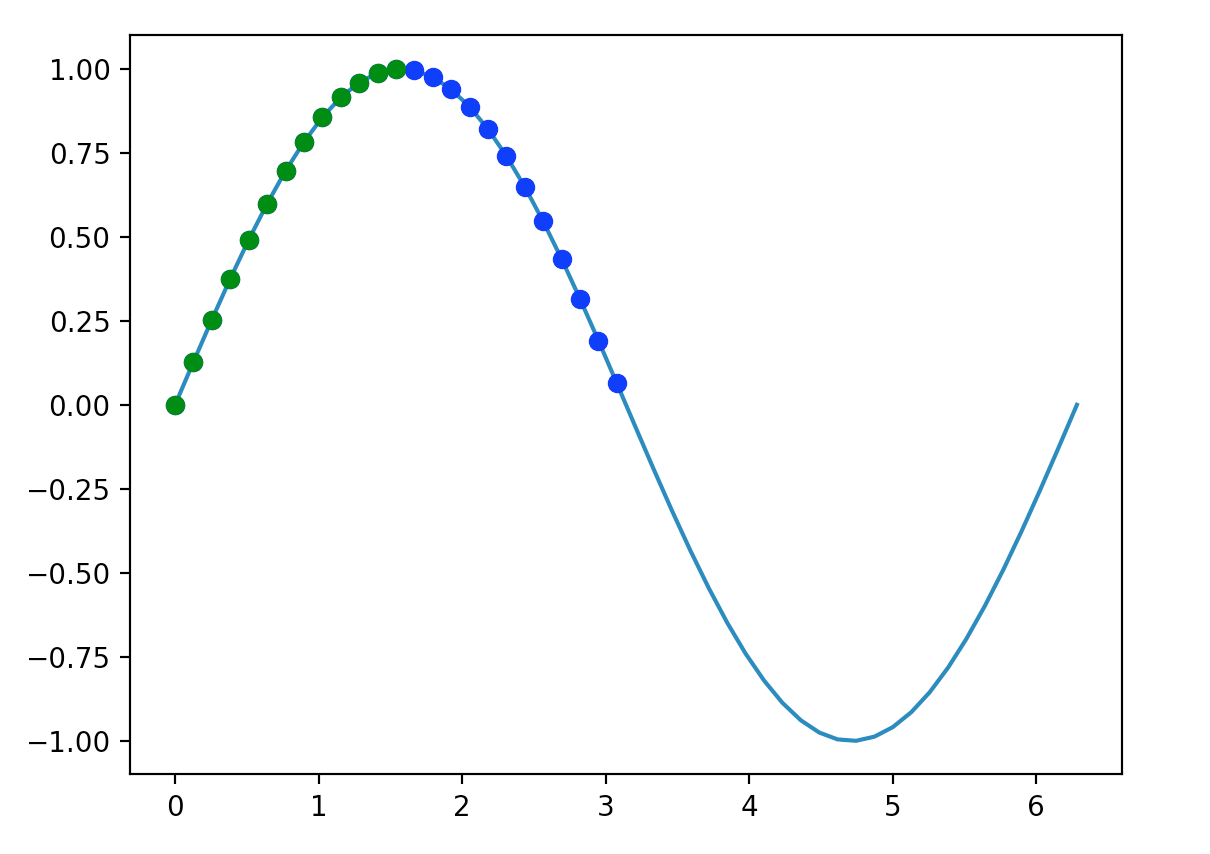numpy 多维数据的理解(三维数据,更多维度)
In [22]: a = np.array([[11, 12, 13, 14, 15], ...: [16, 17, 18, 19, 20], ...: [21, 22, 23, 24, 25], ...: [26, 27, 28 ,29, 30], ...: [31, 32, 33, 34, 35]]) ...: ...: In [23]: a[2][4] Out[23]: 25 In [24]: a[2, 4] Out[24]: 25
索引切片
如你所见,通过对每个以逗号分隔的维度执行单独的切片,你可以对多维数组进行切片。因此,对于2D数组,我们的第一片定义了行的切片,第二片定义了列的切片。
# MD slicing print(a[0, 1:4]) # >>>[12 13 14] print(a[1:4, 0]) # >>>[16 21 26] print(a[::2,::2]) # >>>[[11 13 15] # [21 23 25] # [31 33 35]] print(a[:, 1]) # >>>[12 17 22 27 32]
https://blog.csdn.net/weixin_30556959/article/details/96998739
花式索引
花式索引(Fancy indexing)是获取数组中我们想要的特定元素的有效方法。
# 向量 a = np.arange(0, 100, 10) indices = [1, 5, -1] b = a[indices] print(a) # >>>[ 0 10 20 30 40 50 60 70 80 90] print(b) # >>>[10 50 90] # 矩阵 In [33]: a Out[33]: array([[11, 12, 13, 14, 15], [16, 17, 18, 19, 20], [21, 22, 23, 24, 25], [26, 27, 28, 29, 30], [31, 32, 33, 34, 35]]) In [34]: idx = [[2, 3, 1], [4, 4, 2]] In [35]: a[idx] Out[35]: array([25, 30, 18])
正如你在上面的示例中所看到的,我们使用我们想要检索的特定索引序列对数组进行索引。这反过来返回我们索引的元素的列表。
布尔屏蔽
布尔屏蔽是一个有用的功能,它允许我们根据我们指定的条件检索数组中的元素。
Boolean masking
import matplotlib.pyplot as plt a = np.linspace(0, 2 * np.pi, 50) b = np.sin(a) plt.plot(a,b) mask = b >= 0 plt.plot(a[mask], b[mask], 'bo') mask = (b >= 0) & (a <= np.pi / 2) plt.plot(a[mask], b[mask], 'go') plt.show()
上面的示例显示了如何进行布尔屏蔽。你所要做的就是将数组传递给涉及数组的条件,它将为你提供一个值的数组,为该条件返回true。
该示例生成以下图:
 

我们利用这些条件来选择图上的不同点。蓝色点(在图中还包括绿点,但绿点掩盖了蓝色点),显示值大于0的所有点。绿色点表示值大于0且小于一半π的所有点。
缺省索引
不完全索引是从多维数组的第一个维度获取索引或切片的一种方便方法。
例如,如果数组a=[1,2,3,4,5],[6,7,8,9,10],那么[3]将在数组的第一个维度中给出索引为3的元素,这里是值4。
# Incomplete Indexing In [40]: a = np.arange(0, 100, 10) In [41]: a Out[41]: array([ 0, 10, 20, 30, 40, 50, 60, 70, 80, 90]) In [42]: a[:5] Out[42]: array([ 0, 10, 20, 30, 40]) In [43]: a[a >= 50] Out[43]: array([50, 60, 70, 80, 90]) In [44]: a[::2] Out[44]: array([ 0, 20, 40, 60, 80])
where函数
where() 函数是另外一个根据条件返回数组中的值的有效方法。只需要把条件传递给它,它就会返回一个使得条件为真的元素的列表。
a = np.arange(0, 100, 10) b = np.where(a < 50) c = np.where(a >= 50)[0] print(b) # >>>(array([0, 1, 2, 3, 4]),) print(c) # >>>[5 6 7 8 9] np.where([[True, False], [True, True]], [[1, 2], [3, 4]], [[9, 8], [7, 6]]) # output array([[1, 8], [3, 4]])
3.数组属性
在使用 NumPy 时,你会想知道数组的某些信息。很幸运,在这个包里边包含了很多便捷的方法,可以给你想要的信息。
# Array properties a = np.array([[11, 12, 13, 14, 15], [16, 17, 18, 19, 20], [21, 22, 23, 24, 25], [26, 27, 28 ,29, 30], [31, 32, 33, 34, 35]]) print(type(a)) # >>><class 'numpy.ndarray'> print(a.dtype) # >>>int64 print(a.size) # >>>25 print(a.shape) # >>>(5, 5) print(a.itemsize) # >>>8 print(a.ndim) # >>>2 print(a.nbytes) # >>>200
数组的形状是它有多少行和列,上面的数组有5行和5列,所以它的形状是(5,5)。
-
itemsize属性是每个项占用的字节数。这个数组的数据类型是int 64,一个int 64中有64位,一个字节中有8位,除以64除以8,你就可以得到它占用了多少字节,在本例中是8。
-
ndim 属性是数组的维数。这个有2个。例如,向量只有1。
-
nbytes 属性是数组中的所有数据消耗掉的字节数。你应该注意到,这并不计算数组的开销,因此数组占用的实际空间将稍微大一点。
4.常见操作
| 操作 | 解释 |
|---|---|
| max | 某个维度最大值 |
| min | 某个维度最小值 |
| mean | 某个维度均值 |
| cursum | 累积和 |
| reshape |
转载于:https://www.cnblogs.com/nowgood/p/Numpyintro01.html
https://blog.csdn.net/weixin_62588253/article/details/128552960
https://blog.csdn.net/weixin_30940783/article/details/96824159
https://blog.csdn.net/weixin_62588253/article/details/128530821